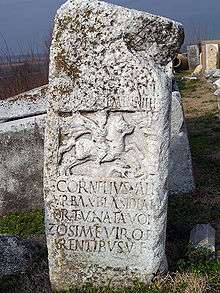Thraco-Roman
The term Thraco-Roman describes the Romanized culture of Thrace under the rule of the Roman Empire.
Historical background
Before the Romans
See also: Getae
Arrival of the Romans
Main article: Thracia
The Odrysian kingdom of Thrace became a Roman client kingdom ca. 20 BC, while the Greek city-states on the Black Sea coast came under Roman control, first as civitates foederatae ("allied" cities with internal autonomy). After the death of the Thracian king Rhoemetalces III in 46 AD and an unsuccessful anti-Roman revolt, the kingdom was annexed as the Roman province of Thracia.[1]
Language
Religion

"Thracian horseman" relief with Latin inscription at Philippi.
Archaeological sites
- The Thraco-Roman Villa Rustica near Chatalka, Stara Zagora, Bulgaria[2]
- Thraco-Roman Cult Complex built in the rocks near Strelkovo, Bulgaria[3]
Famous individuals
This is a list of several important Thraco-Roman individuals:
- Maximinus Thrax, Roman Emperor from 235 to 238.
- Dionysius Exiguus, a 6th-century monk born in Scythia Minor, most likely of local Thraco-Roman origin.[4]:130–131
- Justin I, Byzantine Emperor from 518 to 527, was possibly of Thraco-Roman stock.[5][6][7][8][9]
- Vitalian, an East Roman general who rebelled in 513 against Emperor Anastasius I (r. 491–518). Vitalian may have been of local Thracian stock, born in Scythia Minor or in Moesia; his father bore a Latin name, Patriciolus, while two of his sons had Thracian names and one a Gothic name.[4]:129
- Justinian I, Byzantine Emperor from 527 to 565 and born in Tauresium[10] around 482.[11] His Latin-speaking peasant family is believed to have been of Thraco-Roman or Illyro-Roman origins.[12][13][14]
- Belisarius, a general during the reign of Justinian I. He was born in Germane (nowadays Sapareva Banya) in Western Thrace, possibly of Thracian[15] origin. Commanded several campaigns for reconquering Mediterranean territory of the former Western Roman Empire.
See also
Further reading
- (Romanian) Sorin Olteanu, The administrative organisation of the Balkan provinces in the 6th century AD
- (English) Stelian Brezeanu: Toponymy and ethnic Realities at the Lower Danube in the 10th Century. “The deserted Cities" in Constantine Porphyrogenitus' De administrando imperio
- (English) Kelley L. Ross The Vlach Connection and Further Reflections on Roman History
Notes
- ↑ Soustal (1991), pp. 59–60
- ↑ Dimitŭr Nikolov, "The Thraco-Roman Villa Rustica near Chatalka, Stara Zagora, Bulgaria", British Archaeological Reports, 1976
- ↑ Second Meeting of the Expert Working Group: The 50 Most Attractive Tourist Sites in the Cross Border Region of Dobrudzha, http://www.dobrudzhatour.net/resources/72/doc_1333365852.pdf
- 1 2 Patrick Amory, People and Identity in Ostrogothic Italy, 489–554, Cambridge University Press, 2003.
- ↑ Russu, Ion I. (1976). Elementele traco-getice în Imperiul Roman și în Byzantium (in Romanian). veacurile III-VII. Editura Academiei R. S. România. p. 95.
- ↑ Iv Velkov, Velizar (1977). Cities in Thrace and Dacia in Late Antiquity: (studies and Materials). University of Michigan. p. 47.
- ↑ Browning, Robert (2003). Justinian and Theodora. Gorgias Press LLC. p. 23. ISBN 1-59333-053-7.
- ↑ Johnson, Scott Fitzgerald (2006). Greek Literature in Late Antiquity. Ashgate Publishing. p. 166. ISBN 0-7546-5683-7.
- ↑ Norwich, John Julius (1997). A Short History of Byzantium. Vintage Books. p. 59. ISBN 0-679-77269-3.
- ↑ The precise location of this site is disputed; the possible locations include Justiniana Prima near the modern town of Lebane in southern Serbia and Taor near Skopje, Republic of Macedonia.
- ↑ Cawley, Charles (14 February 2011). "Medieval Lands: Byzantium 395–1057". Foundation for Medieval Genealogy. fmg.ac. Retrieved 20 February 2012.
- ↑ Justinian referred to Latin as being his native tongue in several of his laws. See Moorhead (1994), p. 18.
- ↑ The Cambridge Companion to the Age of Justinian by Michael Maas
- ↑ Justinian and Theodora Robert Browning, Gorgias Press LLC, 2003, ISBN 1-59333-053-7,p. 23.
- ↑ Tucker, Spencer C. (2010). Battles that changed history : an encyclopedia of world conflict (1st ed.). Santa Barbara, Calif.: ABC-CLIO. p. 88. ISBN 978-1-59884-429-0.
References
- Nicolae Saramandru: “Torna, Torna Fratre”; Bucharest, 2001–2002; Online: .pdf.
- Nicolae-Şerban Tanaşoca: “«Torna, torna, fratre» et la romanité balkanique au VI e siècle” ("Torna, torna, fratre, and Balkan Romanity in the 6th century") Revue roumaine de linguistique, XXXVIII, Bucharest, 1993.
- Nicolae Iorga: “Geschichte des rumänischen Volkes im Rahmen seiner Staatsbildungen” ("History of the Romanian people in the context of its statal formation"), I, Gotha, 1905; “Istoria românilor” ("History of the Romanians"), II, Bucharest, 1936. Istoria României ("History of Romania"), I, Bucharest, 1960.
- Elton, Hugh (1996). Warfare in Roman Europe, AD 350-425. Oxford University Press. ISBN 978-0-19-815241-5.
This article is issued from Wikipedia - version of the Thursday, January 07, 2016. The text is available under the Creative Commons Attribution/Share Alike but additional terms may apply for the media files.